| Active projects:
|
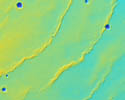
| Thrust faults on Mars: The surface of Mars is covered with compressional tectonic features called wrinkle ridges and lobate scarps. We use the topography of these structures to reveal the geometry of faults at depth. This work provides key information about the history of strain and geodynamics on Mars.
|
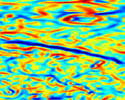
| Ancient dikes on the Moon: GRAIL gravity data has shown that
the Moon is criss-crossed by linear
gravity anomalies, which may reveal the presence of ancient dike-like intrusions. Grad student Weigang Liang is studying the properties, structure, and origin of these mysterious features.
|
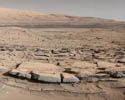
| Lakes and climate on Mars: The MSL-Curiosity rover discovered lake sediments within Gale crater on Mars - but what does that mean for the climate? Postdoc Dave Horvath is using geologic constraints on the existence of lakes to constrain models of the climate and hydrology of early Mars, finding that early Mars was neither very wet nor very dry, but semi-arid.
|
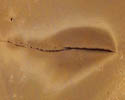
| Recent volcanism on Mars: A dark halo surrounding one of the
Cerberus Fossae fissures is interpreted as a pyroclastic deposit from an explosive
volcanic eruption <1 million years ago. Postdoc Dave Horvath is studying the age
and properties of this youngest volcanic deposit on Mars.
|
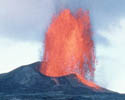
| Explosive volcanism on Mars: The young deposit in Cerberus is one of a number of examples of explosive basaltic volcanism on Mars. Postdoc Pranabendu Moitra is investigating the mechanism behind such eruptions, including the roles of magmatic volatiles and external sources of water and ice.
|
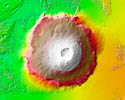
| Climatic control of martian volcanism: Ancient ash deposits on Mars show a periodicity similar to the climate cycles occurring at those times. Could climate be controlling volcanism? Former post-doc Alex Evans has been investigating the role of glaciers deposited on the volcanism during times of high obliquity in controlling the volcanic eruptions.
|
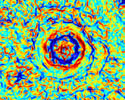
| Multi-ring basins: Lunar impact basins are surrounded by bulls-eye
patterns of scarps and gravity anomalies that reveal the existence of ring faults cutting
through the crust and down into the mantle. We are using gravity data to study the
structure and formation of these multi-ring basins.
|
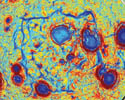
| Lunar Procellarum region:
Lurking beneath the volcanic plains on the nearside of the Moon is a giant
rectangular pattern of gravity anomalies 2000 km across that went undetected until 2014.
Procellarum is the largest magmatic-tectonic province on the Moon, but is still poorly
understood. The structures resemble ancient rift valleys buried beneath the lava flows,
at odds with the conventional view of the Moon as a relatively inactive body. We are trying to understand what these structures are and what they mean for lunar evolution.
|
| Past projects:
|
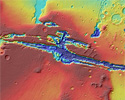
| Valles Marineris: This enormous martian canyon system is ~2000 km long, 100 km wide, and 8 km deep... but how did it form? I have investigated the structure and formation of this unique tectonic canyon, proposing a new model for its formation based on its unique setting within the Tharsis volcanic rise.
|

| Martian hemispheric dichotomy: I am investigating the possibility that the dichotomy
between the southern highlands and northern lowlands may have been the result of a giant impact.
|

| Strike-slip faults on Mars: I have mapped a new population of ancient strike-slip
faults on Mars and used them to shed light on the thermal and tectonic evolution of the planet.
|
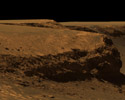
| Meridiani Planum: The MER Opportunity rover has found evidence for
evaporites at Meridiani. I am using global scale hydrological models to understand the origin of
these deposits and their implications for the history of water and climate on Mars.
|
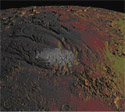
| Mars south polar cap density: I am using a combination of MOLA topography,
gravity data from the MRO spacecraft, and radar sounding from MARSIS to calculate the density of the
south polar layered deposits on Mars.
|
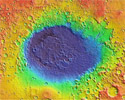
| Giant impact basins: The surfaces of Mars and the Moon are marred by
several giant impact basins, including Hellas, Utopia, and the South Pole-Aitken basin. I am
trying to understand why these basins appear the way they do.
|
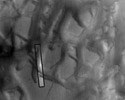
| Martian outflow channel floods: Many of the martian outflow channels originate
in regions of disrupted ground called "chaos regions". I have used numerical modeling to show
that these floods would likely have been periodic.
|
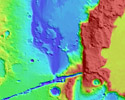
| Earthquake-triggered floods on Mars: Several Martian outflow channels
originate within tectonic features (including Mangala and Athabasca Valles). I have demonstrated
that the tectonism itself could have pressurized the aquifers and directly caused the flooding.
|
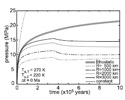
| Climate change and hydrology: It has been suggested that dramatic changes
in the Martian climate could have triggered the outflow channel floods. In modeling this process
I have found that the required pore pressures and flood volumes could not likely be produced by this
mechanism alone.
|

















